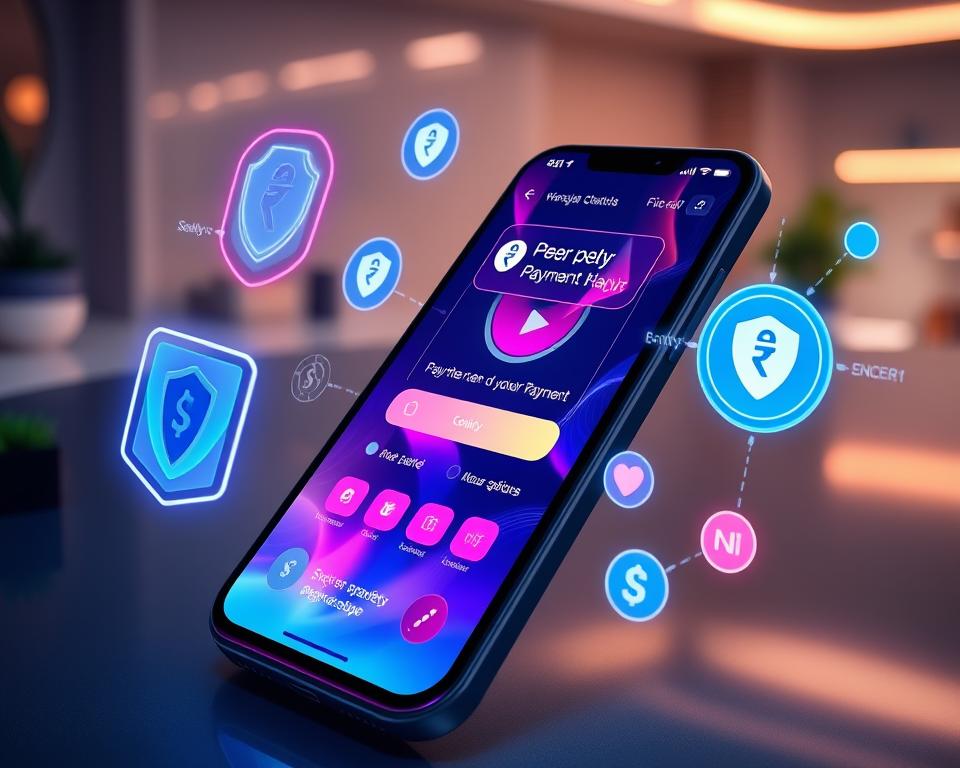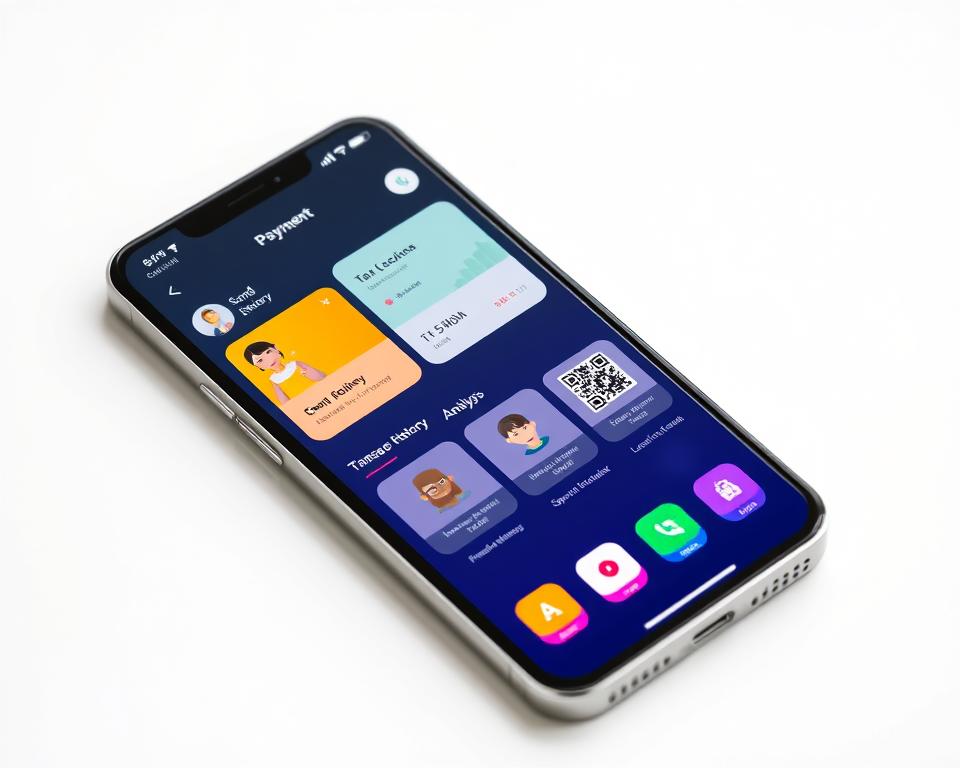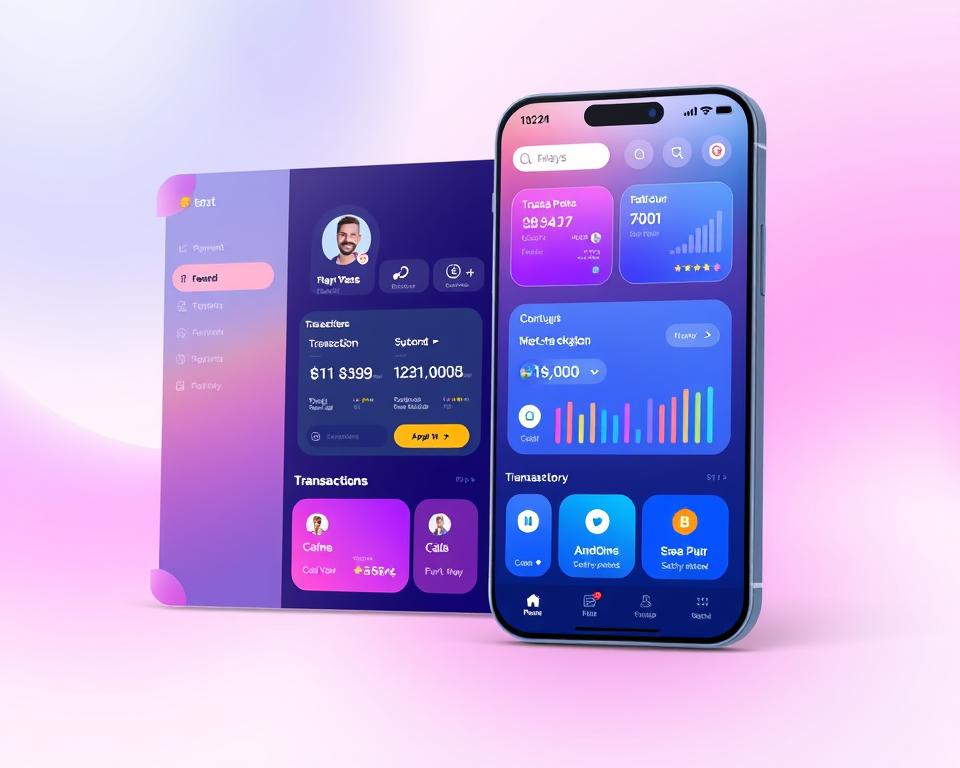The digital payment world is changing fast. Apps like Venmo have changed how we handle money. Now, making a FinTech app like Venmo is a big chance for businesses and entrepreneurs.
This article will cover what you need to make a FinTech app like Venmo. We’ll look at the important features and strong security needed for a reliable digital payment app. We’ll also talk about the latest trends, technical needs, and best practices in FinTech. This will help you make a Venmo-like app that meets today’s user needs.
Table of Contents
Key Takeaways
- Understand the evolving FinTech payment landscape and the rise of P2P payment solutions
- Identify the essential technical requirements for building a secure and user-friendly P2P payment app
- Explore the core features and functionalities that define a modern payment app experience
- Implement robust security protocols and compliance measures to ensure the safety of user data and transactions
- Optimize the user interface design and integrate seamless payment processing to deliver a delightful user experience
Understanding the FinTech Payment Landscape
The FinTech industry has changed how we handle money, making it easier and more efficient. It has brought new ways for people and businesses to manage their finances. This change is driven by several key trends that are shaping the future of payments.
Current Market Trends in Digital Payments
The digital payment market is growing fast. This is because more people use mobile devices and prefer not to use cash. Trends like contactless payments, buy-now-pay-later (BNPL) options, and digital wallets in e-commerce are changing how we pay.
Key Players and Market Share Analysis
Big names like PayPal, Square, and Apple Pay lead the FinTech payment world. They have a lot of market share because of their innovative features, easy-to-use platforms, and strong security. Looking at their market share helps us understand the competition and new trends in digital payments.
Evolution of P2P Payment Solutions
P2P payment solutions have been a big part of the FinTech revolution. Old banking methods have been replaced by mobile apps like Venmo and CashApp. These apps make it easy and safe to send money, changing how we handle our daily finances and connect with friends.
| FinTech Trend | Market Share | Key Players |
|---|---|---|
| Contactless Payments | 35% | Apple Pay, Google Pay, Samsung Pay |
| BNPL Solutions | 25% | Affirm, Afterpay, Klarna |
| Digital Wallets | 40% | PayPal, Venmo, CashApp |
The FinTech payment world is always changing, with new trends and solutions popping up. It’s important for businesses and individuals to understand this fast-paced world. This way, they can make the most of digital payments and stay ahead in the financial technology landscape.
Essential Technical Requirements for Building a P2P Payment App
Creating a strong P2P payment app needs a solid base. Choosing the right programming languages, frameworks, and tools is key. A scalable backend is also vital to handle more users and transactions.
For a P2P app’s technical stack, some top choices are:
- Programming Languages: Java, Kotlin, Swift, or React Native for the app, and Python, Node.js, or Ruby on Rails for the backend.
- Frameworks: Spring Boot, Django, or Express.js for the backend, and React, Angular, or Flutter for the app’s front end.
- Databases: MySQL, PostgreSQL, or MongoDB for user data and transaction history.
- Payment Gateways: Stripe, PayPal, or Braintree for secure transactions.
- Cloud Services: AWS, Google Cloud, or Microsoft Azure for scalable hosting.
The app’s architecture should focus on scalability and performance. Use modular design, caching, and efficient data management. The backend must be strong and secure, with load balancing and disaster recovery in mind.
| Component | Recommended Technologies |
|---|---|
| Mobile App | Java, Kotlin, Swift, React Native |
| Backend | Python, Node.js, Ruby on Rails |
| Database | MySQL, PostgreSQL, MongoDB |
| Payment Gateway | Stripe, PayPal, Braintree |
| Cloud Services | AWS, Google Cloud, Microsoft Azure |
By picking the right tech stack and architecture, developers can make a P2P app that’s both rich in features and secure. This meets the changing needs of the FinTech world.
Core Features and Functionality of Modern Payment Apps
Modern payment apps are getting more advanced. They make transactions smooth and meet the needs of tech lovers. Let’s explore what makes these apps great.
User Registration and Authentication Systems
Secure sign-up and login are key to trust and safety. Payment apps use strong ways to check who you are. They might use your fingerprint or face for this.
They also have extra security steps. This makes it harder for others to get into your account.
Transaction Processing Mechanisms
Payment apps are all about making money moves easy. They use new tech for fast, safe, and reliable money transfers. This includes sending money to friends and working with different payment systems.
Social Integration Components
Many apps add social features to keep users engaged. You can meet new people and share your payment moments. This makes the app more fun and helps it grow.
| Feature | Description |
|---|---|
| User Authentication | Secure user verification through biometrics and multi-factor authentication |
| Transaction Processing | Instant, secure, and reliable fund transfers between users |
| Social Integration | Connecting users, sharing payment activities, and fostering a sense of community |
Modern payment apps offer a smooth and safe way to handle money. They meet the changing needs of digital users. As FinTech grows, these features will be even more important for mobile payments.
Backend Infrastructure and System Architecture
Building a FinTech app like Venmo needs a strong backend and a good system design. At the heart is cloud infrastructure. It gives the app the scale, reliability, and flexibility it needs to meet user demands.
A microservices architecture is key for FinTech apps. It lets developers work in modules, scale each part, and keep the app running smoothly. This way, the app stays fast and reliable, thanks to cloud-based backend development and system architecture.
Managing databases is also vital. FinTech apps deal with sensitive financial info. They need secure, fast databases. You can use relational databases or NoSQL databases, depending on what the app needs.
“The backbone of any successful FinTech app is its robust backend infrastructure and well-designed system architecture.”
Putting these backend pieces together improves the app’s user experience, security, and growth. By focusing on cloud infrastructure, microservices architecture, and database management, developers lay a solid base for a secure and feature-rich FinTech app.
Developing a FinTech App Like Venmo: Key Features and Security Protocols
The demand for FinTech apps like Venmo is growing. It’s important to focus on core features and strong security. This ensures a smooth and safe experience for users.
Primary Feature Implementation
A good FinTech app has key features that meet user needs. These include easy user registration and authentication systems, secure transaction processing mechanisms, and social integration components. These features make the app user-friendly and appealing.
Security Layer Integration
Protecting user data is essential in FinTech. Use strong security protocols like end-to-end encryption and multi-factor authentication. Regularly update these to keep up with new threats and keep users safe.
Compliance Requirements
FinTech apps must follow specific compliance regulations. Learn about know-your-customer (KYC) and anti-money laundering (AML) rules. Meeting these standards shows you’re serious about financial responsibility.
By focusing on these areas, you can build a secure and compliant app. It will offer a great user experience and gain user trust.
User Interface Design Best Practices for Payment Apps
Creating a smooth and easy-to-use user interface (UI) design is key for payment app success. By following UI/UX design best practices, developers can make a mobile app that grabs users’ attention. It also builds trust and confidence in their financial dealings.
For a payment app to succeed, it needs a clear and easy transaction flow. Users should find it simple to move through the app’s features. This means having clear menus, short labels, and easy gestures. Reducing confusion and making payments straightforward can greatly improve the user experience.
The look of a payment app is also very important. A clean, modern, and eye-catching design can build trust and keep users engaged. Choosing the right colors, fonts, and icons can make the app look good and feel right.
| Design Element | Best Practice |
|---|---|
| Navigation | Intuitive and consistent menu structure, clear labeling, and responsive gestures |
| Transaction Flow | Streamlined and logical process, minimal cognitive load, clear progress indicators |
| Visual Design | Clean, modern, and visually appealing aesthetics, harmonious color schemes, and legible typography |
Following these UI/UX design best practices helps developers make a payment app that is both enjoyable and trustworthy. This can lead to more user engagement and loyalty.
“Effective payment app interface design is not just about aesthetics, but about crafting an intuitive and seamless user experience that fosters trust and confidence.”
Payment Processing Integration and Gateway Selection
In FinTech app development, integrating payment systems and choosing the right gateways are key. When making a payment app like Venmo, knowing the popular options and solving integration issues is vital. This ensures a smooth user experience.
Popular Payment Gateway Options
Stripe, PayPal, and Square are top choices for payment gateways. They offer a wide range of features, from secure transactions to detailed reports. This makes them great for FinTech app developers.
| Payment Gateway | Key Features | Supported Integrations |
|---|---|---|
| Stripe |
|
|
| PayPal |
|
|
| Square |
|
|
Integration Challenges and Solutions
Developers face many challenges when integrating payment systems into FinTech apps. These include ensuring a smooth user experience, following regulations, and keeping data safe. By planning carefully, testing thoroughly, and using strong security, these issues can be overcome.
“Integrating payment processing into a FinTech app is a complex task that requires careful consideration of user experience, compliance, and security. By working with trusted payment gateways and addressing integration challenges head-on, developers can create a payment app that instills confidence in users and drives business success.”
Data Protection and Encryption Protocols
In the world of FinTech apps, keeping user data safe is key. When making a payment app like Venmo, strong data encryption and cybersecurity are vital. They help build trust and keep financial info safe.
FinTech apps must use SSL/TLS (Secure Sockets Layer/Transport Layer Security) protocols. This top encryption tech makes sure all app-server talks are safe. It keeps user and financial data private while it’s being sent.
End-to-end encryption is also a must. It protects data not just when it’s being sent, but also when it’s stored. This stops hackers from getting to it.
To make data even safer, apps can use things like tokenization. It swaps out real data for fake stuff. They can also use biometric checks like fingerprints or faces to make sure it’s really you.
| Security Protocol | Description | Key Benefits |
|---|---|---|
| SSL/TLS | Industry-standard encryption technology that secures communication between the app and server | Protects data confidentiality during transmission |
| End-to-End Encryption | Advanced encryption method that safeguards data at rest and in transit | Prevents unauthorized access and data breaches |
| Tokenization | Replaces sensitive data with non-sensitive placeholders | Enhances data security and reduces the risk of data exposure |
| Biometric Authentication | Verifies user identity and authorizes transactions using biometric data (e.g., fingerprint, facial recognition) | Improves user authentication and reduces the risk of unauthorized access |
By using these data encryption and cybersecurity tools, app makers can keep user data and money safe. This builds trust and confidence with their users.
Regulatory Compliance and Legal Requirements
In the fast-changing FinTech world, it’s key to understand and follow the rules. This is vital for digital payment apps to succeed and stay safe. Following the law and industry standards helps build trust with users.
KYC Implementation Guidelines
For FinTech apps, strong Know Your Customer (KYC) rules are essential. KYC helps check who is using the app, reducing fraud and money laundering risks. It involves checking personal details like name, address, and ID.
Anti-Money Laundering Protocols
FinTech apps also need to follow strict Anti-Money Laundering (AML) rules. These rules help spot and stop illegal money use. They watch transactions, find odd activities, and report them to follow the law.
| Regulatory Requirement | Key Considerations |
|---|---|
| KYC Compliance |
|
| AML Protocols |
|
By keeping up with FinTech regulations, KYC compliance, and AML protocols, app makers can make sure their apps are legal and safe. This builds trust and credibility with users.
Testing and Quality Assurance Procedures
Creating a solid FinTech app like Venmo needs a detailed testing plan. This includes QA testing, security testing, performance testing, and user acceptance testing. Each step is vital for the app’s stability, security, and ease of use.
Security testing is a big part of app testing. It checks the app’s security, encryption, and data protection. This helps find and fix any weak spots, keeping users’ financial info safe.
Performance testing looks at how well the app handles lots of users and data. It makes sure the app works fast and smoothly, even when lots of people are using it.
- Do thorough QA testing to check if the app works right and is easy to use.
- Use strong security testing to keep user data safe and stop unauthorized access.
- Do performance testing to make sure the app can handle lots of users and data without slowing down.
- Do user acceptance testing to make sure the app works well in real life and is easy for users.
By carefully following these testing steps, FinTech app makers can create a safe, reliable, and easy-to-use payment app. This builds trust and confidence with users.
Scalability and Performance Optimization
In the fast-paced world of FinTech, making sure apps can grow and perform well is key. Payment apps see more transactions, so they need strong load balancing strategies and database optimization techniques. This keeps apps running smoothly and fast.
Load Balancing Strategies
FinTech apps must use smart load balancing to handle more users and transactions. They spread the work over many servers or cloud services. This keeps things running smoothly and prevents slowdowns.
Techniques like horizontal scaling, vertical scaling, and cloud-based load balancing help apps adjust to changing needs. They can grow or shrink as user traffic and transactions change.
Database Optimization Techniques
- Use sharding or partitioning to split data among many databases. This boosts app scalability and performance optimization.
- Try in-memory databases or caching to cut down on database delays. This improves performance optimization.
- Make database queries, indexes, and schema designs efficient. This helps with database optimization.
- Keep an eye on and adjust database settings, like connection pooling and query optimization. This keeps performance optimization at its best.
By using these load balancing and database techniques, FinTech apps can scale up and perform better. This ensures users have a great experience, even when apps are busy.
Fraud Prevention and Risk Management
In the world of FinTech, stopping fraud and managing risks is key. Fraud detection and risk assessment are crucial. They help keep users safe and transactions honest.
Real-time transaction monitoring is a big help. It uses smart algorithms to check user actions and transactions right away. This way, it spots fraud quickly and stops it fast.
Machine learning is also vital. It trains algorithms with lots of data. This helps FinTech apps predict and fight fraud better.
| Fraud Prevention Strategy | Key Benefits |
|---|---|
| Real-time Transaction Monitoring | Rapid identification of suspicious activities, enabling prompt intervention |
| Machine Learning-based Fraud Detection | Adaptive, data-driven models that continuously improve fraud prevention |
| Comprehensive Risk Assessment Models | Holistic evaluation of user profiles, transaction patterns, and contextual factors |
FinTech apps use many strategies to prevent fraud and manage risks. This keeps users trusting them, follows rules, and makes payments safe and reliable.
“Effective fraud prevention is not just about catching bad actors – it’s about building trust and confidence in the entire FinTech ecosystem.”
User Authentication and Identity Verification
In the fast-changing FinTech world, keeping user data safe is key. FinTech companies need new ways to make sure transactions are secure and easy. They must look into new ways to log in that are better than just passwords.
Biometric Authentication Methods
Biometric authentication uses special features like fingerprints or faces to check who you are. FinTech apps are starting to use this tech. It’s safer than passwords because it’s hard to fake.
Multi-Factor Authentication Implementation
FinTech apps are also using multi-factor authentication (MFA). This means you need more than one thing to get into your account. It could be a password, a code sent to your phone, or a scan of your face. This makes it much harder for hackers to get in.
By using biometric authentication and multi-factor authentication, FinTech apps can make logging in safe and easy. This builds trust with their users.
| Authentication Method | Advantages | Challenges |
|---|---|---|
| Biometric Authentication |
|
|
| Multi-Factor Authentication |
|
|
By using the latest in biometric authentication and multi-factor authentication, FinTech apps can make logging in safe and easy. This helps build trust with their users.
“Securing user access is paramount in the FinTech industry, where sensitive financial data is at stake. Innovative authentication methods like biometrics and multi-factor verification are essential for building trust and protecting against fraud.”
Monitoring and Analytics Implementation
In the fast-paced world of FinTech apps, app analytics, performance monitoring, and user behavior tracking are vital. They help drive data-driven insights and lead to constant improvements. By using strong monitoring and analytics tools, FinTech app developers can understand their users better. They can see how users act, what they do, and how the app performs.
User behavior tracking is a key part of this. It lets developers watch how users use the app, where they go, and how they interact with it. This helps find problems, make the app better, and make smart choices to improve it.
Performance monitoring is also crucial. It lets developers check how well the app works, like how fast it is and how much it uses resources. This info helps find slow spots, make the app run smoother, and keep users happy, even when lots of people are using it.
The insights from app analytics can also help with marketing and keeping users. By looking at who uses the app, what they buy, and how they interact, developers can make the app better fit their users. This helps keep users happy and loyal over time.
In the end, using good monitoring and analytics tools in FinTech apps helps developers make data-driven decisions. This leads to better performance and a better experience for users. It’s a big part of why FinTech apps succeed in a tough market.
“The key to success in the FinTech industry lies in the ability to make informed decisions based on comprehensive data analysis and user insights.”
Conclusion
Creating a secure and feature-rich FinTech app like Venmo is a challenge. It needs a mix of new user experiences and strong security. The world of FinTech payments has changed fast, with digital wallets and P2P solutions leading the way.
To make a FinTech app that works, you must focus on technical needs, key features, and security. Using the latest in authentication, encryption, and fraud prevention is key. This way, developers can build trust and confidence with their users.
The future of digital payments looks exciting, with new tech like biometrics, blockchain, and AI on the horizon. As FinTech keeps evolving, success will depend on combining user-friendly design with top-notch security. This ensures FinTech apps stay ahead in the digital payment world.



















